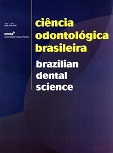Estudo comparativo da influência do método de posicionamento convencional e natural de cabeça para obtenção de radiografias laterais cefalométricas utilizando a análise crânio-cervical
DOI:
https://doi.org/10.14295/bds.2009.v12i1.253Abstract
Atualmente, a cefalometria passa por questionamentos com relação a sua precisão em avaliar o grau e a localização da deformidade a ser tratada. A obtenção das radiografias laterais cefalométricas pela metodologia da postura natural da cabeça tem pouca popularidade no Brasil, talvez pelos poucos estudos existentes sobre o tema. Sendo assim, o objetivo no presente estudo foi verificar se houve diferença nos valores do traçado cefalométrico crânio-cervical, realizado em radiografias laterais cefalométricas digitalizadas obtidas pelas técnicas convencional e com postura natural de cabeça (PNC). Para tal propósito 92 indivíduos com idade cronológica entre 7 a 12 anos foram utilizados no estudo. Tais indivíduosforam radiografados duas vezes, sendo uma pelo método convencional e outra pelo método da postura natural da cabeça. A diferença entre os métodos foi verificada pelo teste de variância Anova dos valores da análise crânio-cervical
realizada nas radiografias. Não foram encontradas diferenças estatísticas significantes entre os métodos de posicionamento para obtenção de radiografias laterais cefalométricas. A partir de tais resultados a necessidade da obtenção de radiografias laterais cefalométricas em PNC para a realização da análise crânio-cervical pode não ser fator determinante para a exatidão da análise.
Downloads
Downloads
Published
How to Cite
Issue
Section
License
Brazilian Dental Science uses the Creative Commons (CC-BY 4.0) license, thus preserving the integrity of articles in an open access environment. The journal allows the author to retain publishing rights without restrictions.
=================




























